If you are a woman, or if you at least had a sister growing up, it is very possible that there was a ballerina music box in your house. If not a ballerina, then some other meaningful symbol expressing the output of a mechanical musical mystery.
My sister had one, and I, of course, would play around with it. Sometimes I was trying to be annoying (I am the little brother, after all), but other times, it was just so fascinating to discover the mechanism plucking away, creating music.
What I didn’t know then was that I came in at the end of a long and storied history surrounding the “simple” music box and other automated musical machines.
Music boxes came into being around the same time as automated mechanical musical instruments in the ninth-century city of Baghdad during the Islamic Golden Age. They were water-powered organs utilizing cylinders with raised pins, just like those found in modern-day music boxes.
That cylinder remained the basic device for mechanically replicating music for almost one thousand years. In the 1770s, the musical notes were, for the first time, created not using bells or chimes, but rather through a forerunner to the musical “comb” of steel prongs found in the basic music boxes today. The now-familiar tuned steel comb first appeared 1796.
Shortly after, around 1800, the first radial pinned disks appeared in pocket watches and music boxes as an alternative to pinned cylinders and drums. These were widely used in music boxes and became a main variant, allowing for a flatter music machine while maintaining the ability to play a comparable range of notes. This style was rare in musical pocket watches, but it did allow for variation from the pin cylinder configuration.
Golden decline
After this, the advancements were generally focused on tone and amplified sound as the general mechanism was considered suitable for what makers hoped to achieve. When Thomas Edison invented the phonograph in 1877, the eventual end of the thriving music box industry was sealed. Over time, the mechanism became a novelty. The effects of World War I combined with the eventual economic collapse of 1929 largely finished the luxury music box industry.
But the technology remained, as did a handful of companies, including the last remaining Swiss luxury music box producer Reuge.
Fast forward to the modern day, when the technology appears in a new and glorious way: in a wristwatch.
Point of note: adding a music box function to a watch is rather old, extending back close to 300 years. These were obviously pocket watches since there were only a handful of real wristwatches created before the beginning of the 1900s.
It is not certain when the first disc-based music box function in a wristwatch appeared, but the first one I am aware of was the Breguet Réveil La Musicale, which debuted in 2010 (to see this watch in action, please read How It’s Made: Inside The Breguet Castle Of Complications).
In 2013, the category expanded and the first wristwatch with a visible music box mechanism burst onto the scene: Stranger by Ulysse Nardin. And no, it was not inspired by the Albert Camus novel of the same name. The Ulysse Nardin Stranger is the most interesting music box watch out right now.
And after two collection editions, Ulysse Nardin has released a unique piece for Only Watch 2015.
Music to my . . . wrist
So why is this watch something special, and where did it get its name? The answer to the second question is rather straightforward: the music box function on the first limited edition played Frank Sinatra’s “Strangers in the Night.” I told you it was pretty straightforward. (To read about this watch, please see Stranger: Ulysse Nardin’s World-First Music Box Wristwatch.)
The brand followed that up in 2015 with the second limited edition engineered to play “Violin Concerto No. 1” in E from The Four Seasons by Antonio Vivaldi (read Ulysse Nardin’s Stranger Music Box Wristwatch Now Plays Vivaldi). Both were limited to just 99 pieces, but those numbers are entirely pedestrian compared to the most recent edition for Only Watch 2015, which is a one-of-one unique example.
It is also unique in other ways, which I’ll get to later.
I want to get into the mechanism first and describe exactly how it works. It all starts with the disc, that great big feature so visible on the dial. On that disc are miniature steel pins that pluck the teeth of the comb to play the notes. The number of pins used depends on which song is “programmed” on the disc; the Vivaldi disc has more than 80 pins.
These pins are used to “pluck” one of the ten peripherally anchored blades (teeth of the comb), which are actually the tuned fingers creating the tone or note. When the pin passes underneath the blade, a beveled extension rides over the pin and then falls off its rear side. This falling action is what creates the vibration and tone in the blade, not an actual “striking” of the blade.
The construction of these blades is very individual to each piece, just like gongs on a repeater; each one needs to be individually tuned to the exact note. This takes a very skilled hand to perform correctly because if just a tiny amount of metal is removed in the tuning process, that blade goes from a G to a G♯, and the melody is ruined.
Adding material back for the miniscule amount that would change the pitch is nearly impossible. Yet a slightly sharp or flat note isn’t as bad as a melody that is completely off because of poor pin placements.
Put a pin in it
These pins are spaced at very exacting distances around the disk, and that is something that takes a fair amount of planning to pull off. As the disc rotates, the pins placed toward the center will move much more slowly than the pins on the outside edge of the disc since the disc is solid and rotates at one speed. Technically, the pins are all moving at the same rpm (rotations per minute), but those on the edge cover more distance during that revolution.
This means that to have the same tempo on the outer edge as in the center, the distance between the pins must be multiplied by an amount relative to the pins’ radial distance from the center.
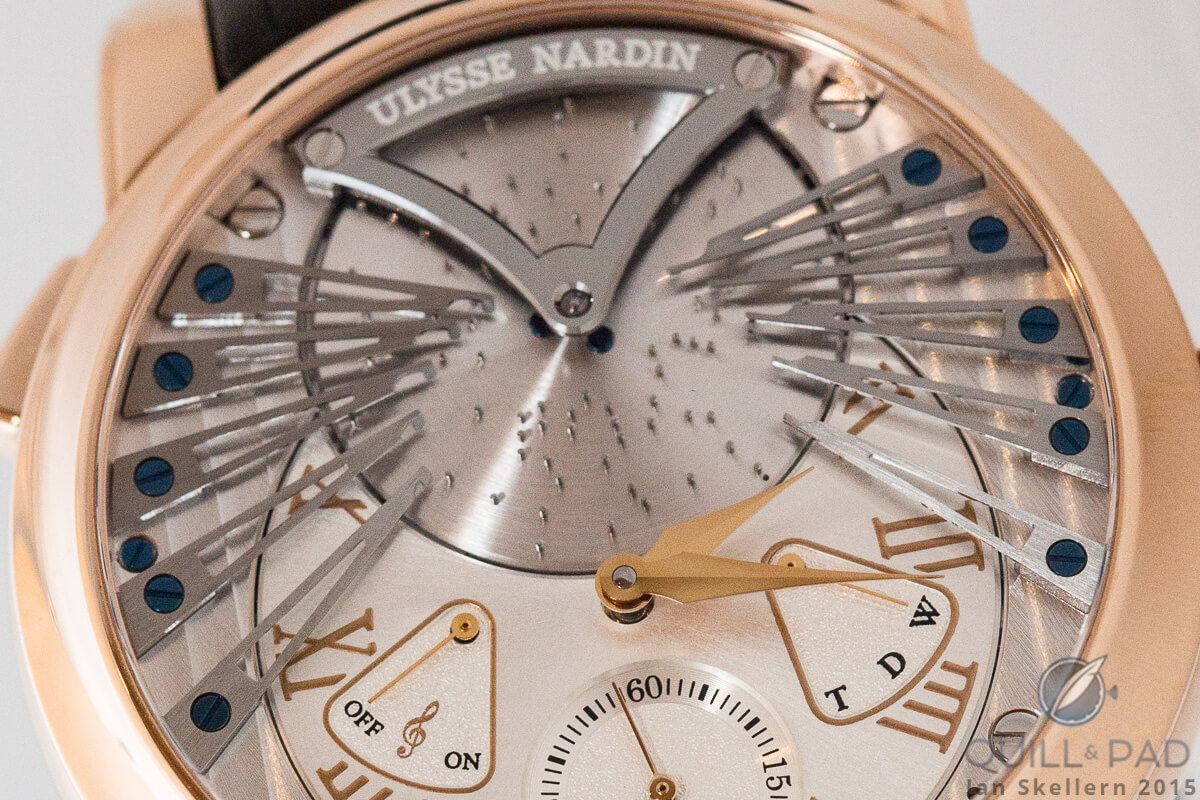
As the disc at the top of the dial of the Ulysse Nardin Stranger rotates, carefully positioned pins pluck tuned blades to create music
Math fans, feel free to add the precise formula needed . . . I’m guessing something like π x r/ rpm?
Really, it doesn’t matter because the best way to calculate these positions would be to imagine a straight line from the center of the disc to the edge and use that as a beat. Calculate one distance from the center multiplied by the rpm and that will be your beats per minute, bpm. Then, if you know the actual melody and time signature, you can place the notes (pins) on their corresponding lines radiating from the center. This only requires one set of calculations, and the rest of the notes are determined relative to the first one.
The final aspect of creating the perfectly flowing melody is to control the speed at which the disc rotates, determining actual running bpm. This is usually achieved by either a centrifugal governor limiting the speed (a heavy weight spinning around, like on a repeater), or a straight set of wheels geared down to result in appropriate rotational speed for the final gear, which happens to be the disc.
It gets even better
The next bits of awesome come in the way you interact with the watch. First, the melody can be set to play at the top of the hour (sonnerie-style) or turned off entirely. You also have the ability to play it on demand whenever you desire. These functions are controlled by two pushers on the left side of the case, different from the traditional repeater’s activator slide. This is because it is driven by a large mainspring that is wound along with the movement, and therefore does not need to be wound each time you want to hear it, as with a repeater.
Moving on, we get to the setting and winding of the watch, programmed in a much more tactile way. Normally we watch lovers need to pull out the crown (sometimes unscrewing it) to change the date or time or to wind it. The Stranger utilizes a button in the center of the crown as a selector, which allows the wearer to cycle between time, date, and winding by watching an indicator on the dial. This simply has a better feel to it as pushers are really an ideal way to select something instead of pulling on a possibly delicate crown.
With all of the mechanics discussed, you are left with a watch that stands out visually as much as it does mechanically. This goes for many Ulysse Nardin pieces, of course. The layout of the dial with its long, skeletonized blades, rotating disk supported by a very clean bridge, and subdials and indicators, all make for a more than glance-worthy timepiece.
With the new Only Watch 2015 version, things get even more interesting. The case is crafted in blackened titanium, the dial is anthracite-colored, and the blades are a bright cherry red. It is a visually aggressive watch compared to the subtle and classic gold with silver dials of the original two models.
And the song choice follows suit.
The song for the Only Watch 2015 Stranger is something that holds meaning for Ulysse Nardin CEO Patrik Hoffmann, who states that, “The Monaco Association against Muscular Dystrophy is led by champions for champions.” Following this quote, the song choice is very apropos and equally strong to match the timepiece style. Choosing “We Are The Champions” by Queen, the UN Stranger Only Watch 2015 edition probably becomes the first music box watch to feature a rock-and-roll power ballad.
For that reason alone, this watch would be awesome, but combined with the mechanics involved, the history of the music box going all the way back to 900 BCE in Baghdad, and the avant-garde design, this watch tops out as increditastic! Now, to scrape up enough money to bid on it during the Only Watch auction coming up. Wish me luck!
For more information, please visit www.ulysse-nardin.com.
Quick Facts: Stranger Vivaldi Primavera
Case: 45 mm, pink gold
Movement: automatic Caliber UN-690 with music box function and function selector
Functions: hours, minutes, seconds; date, melody sonnerie
Limitation: 99 pieces
Price: $112,000





















































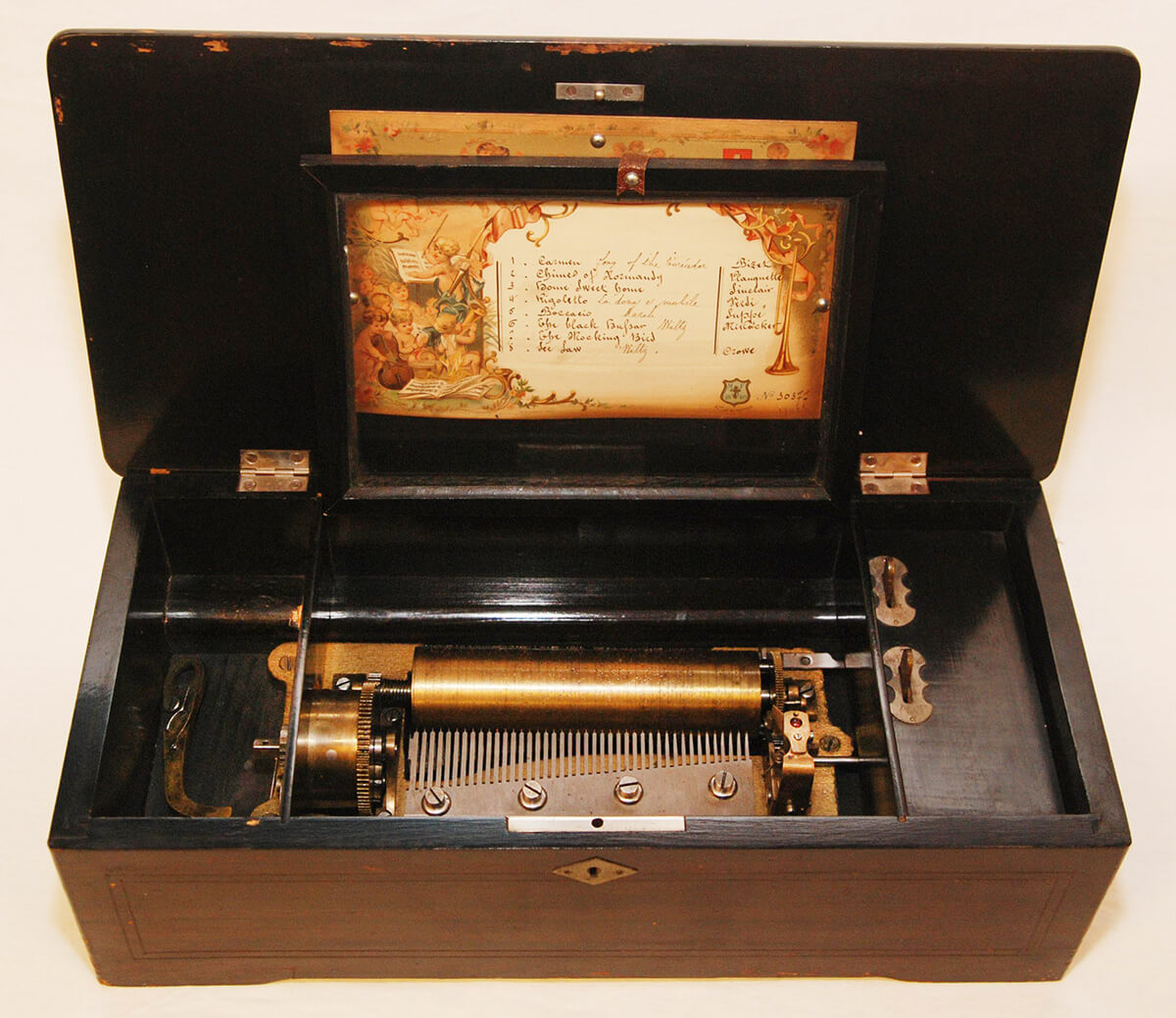
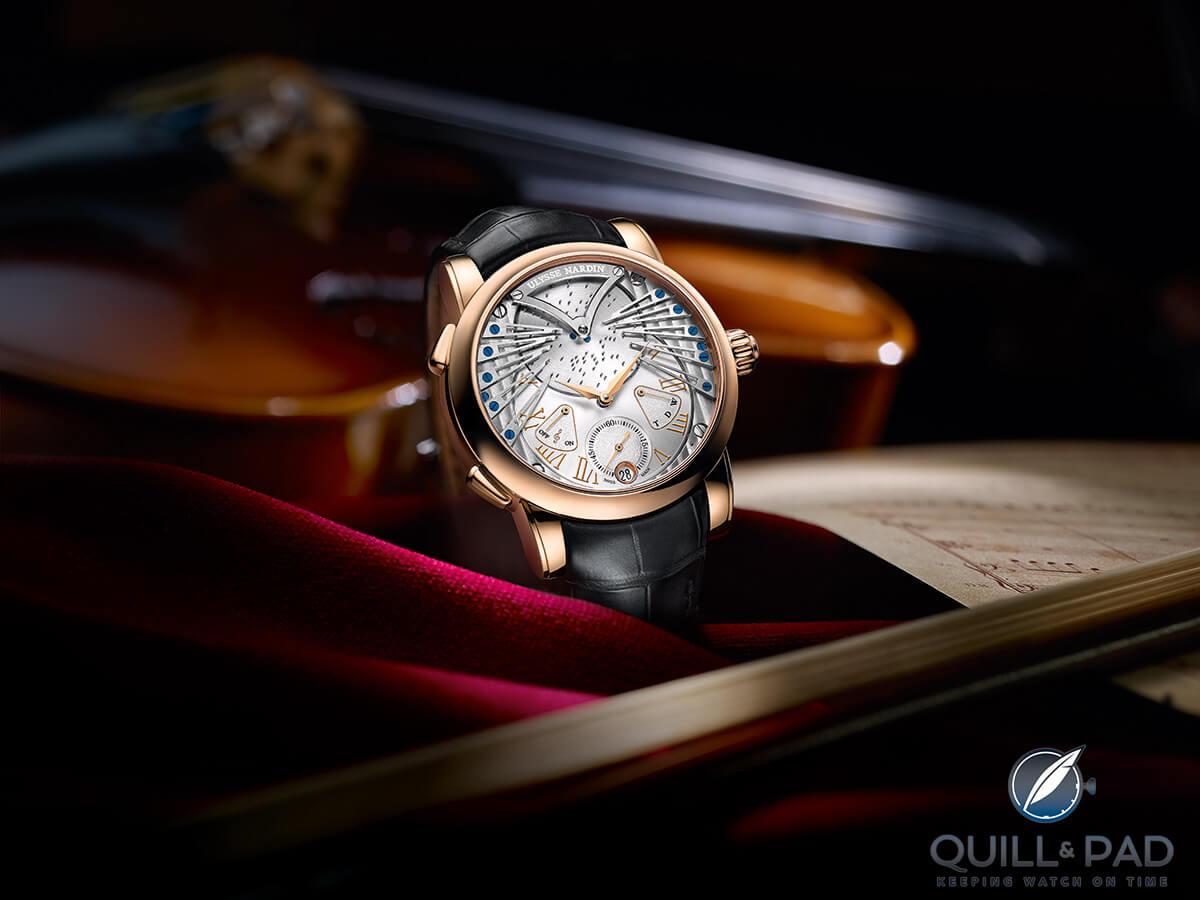

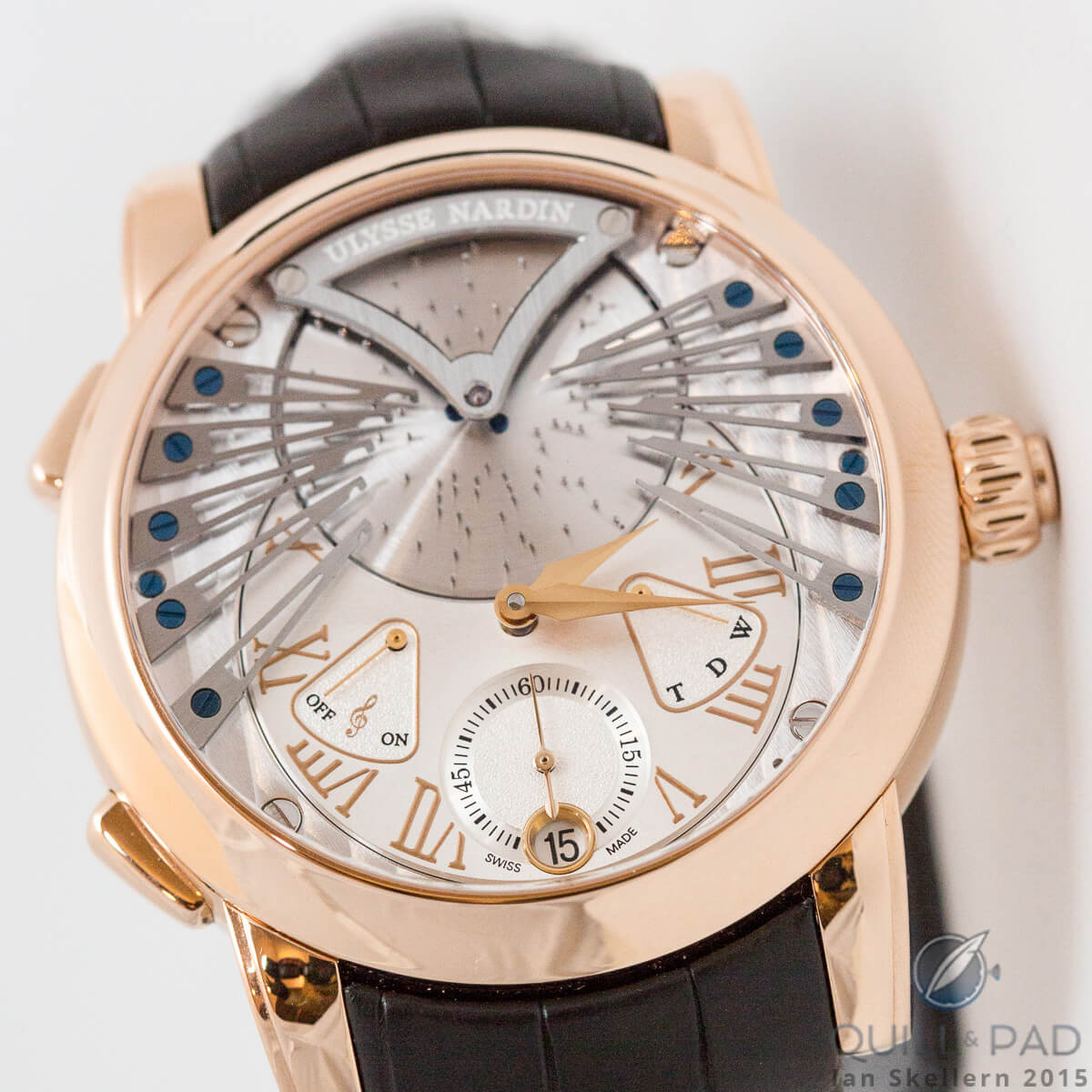
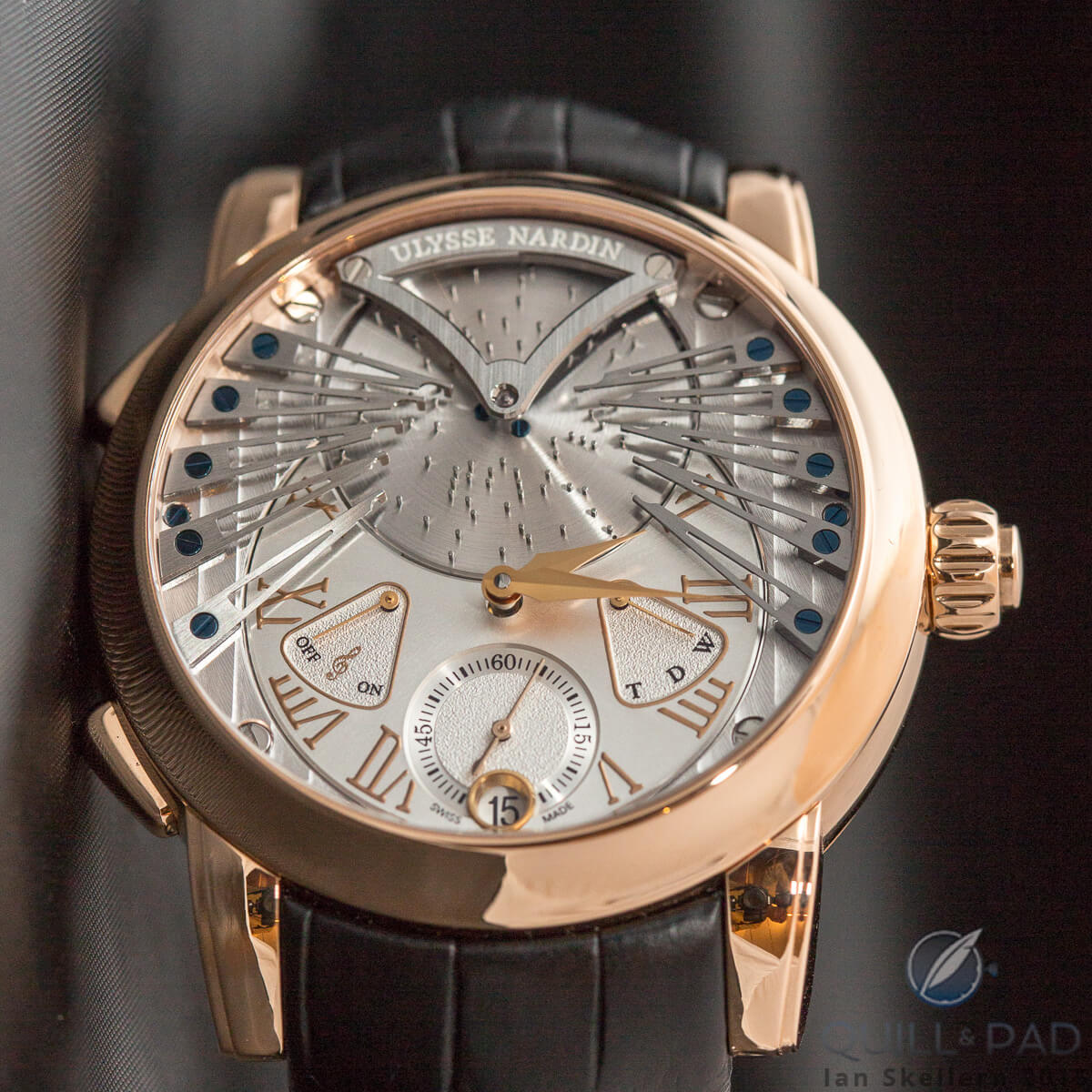
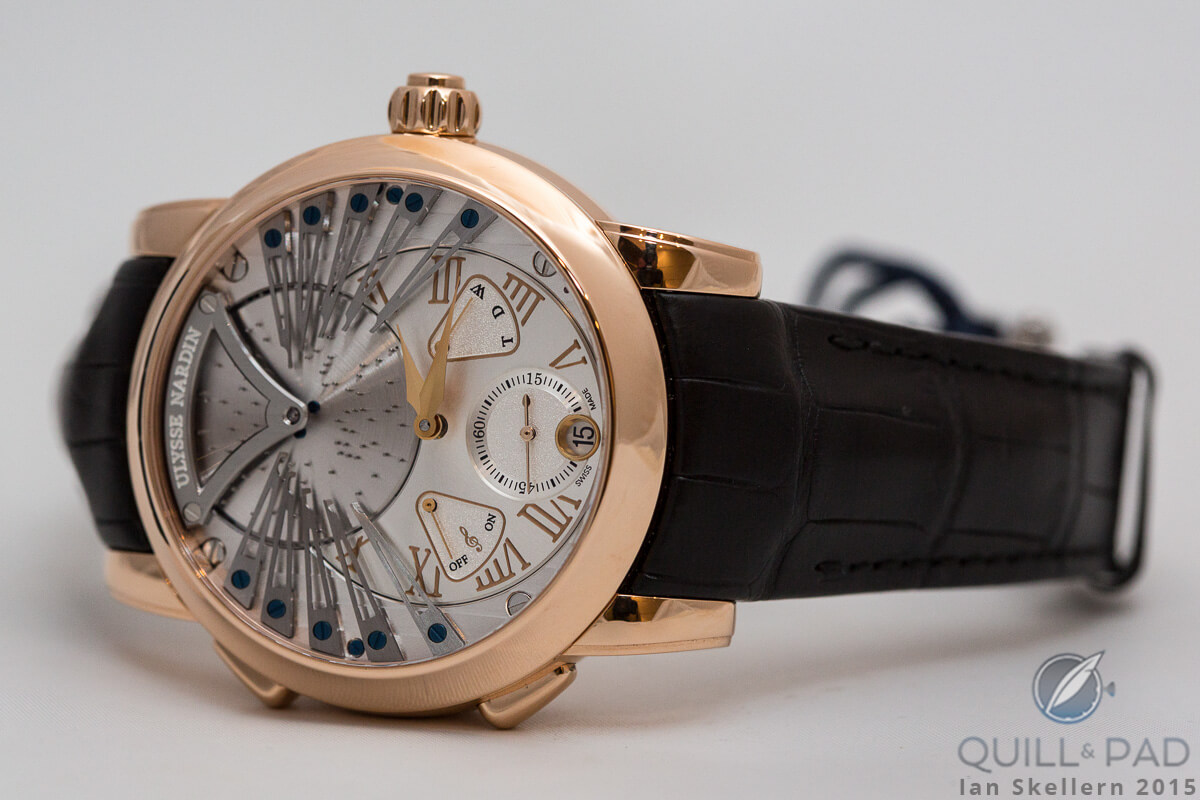
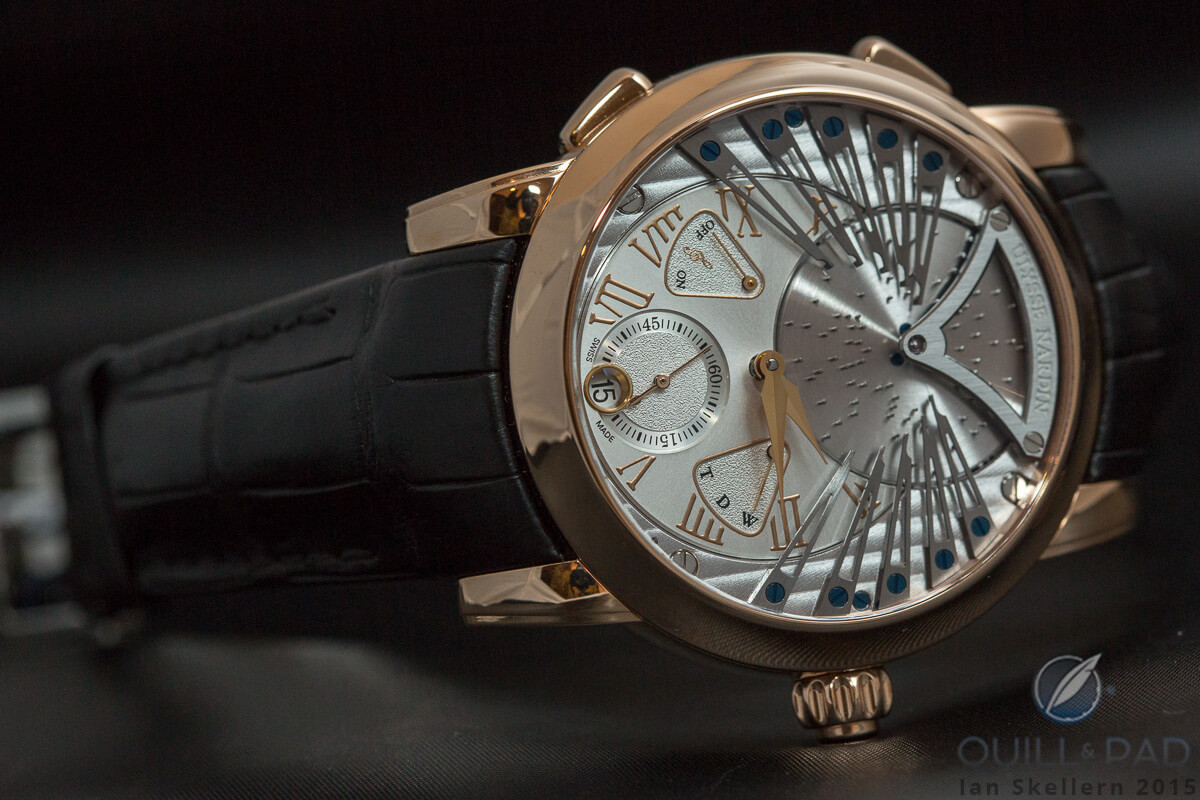
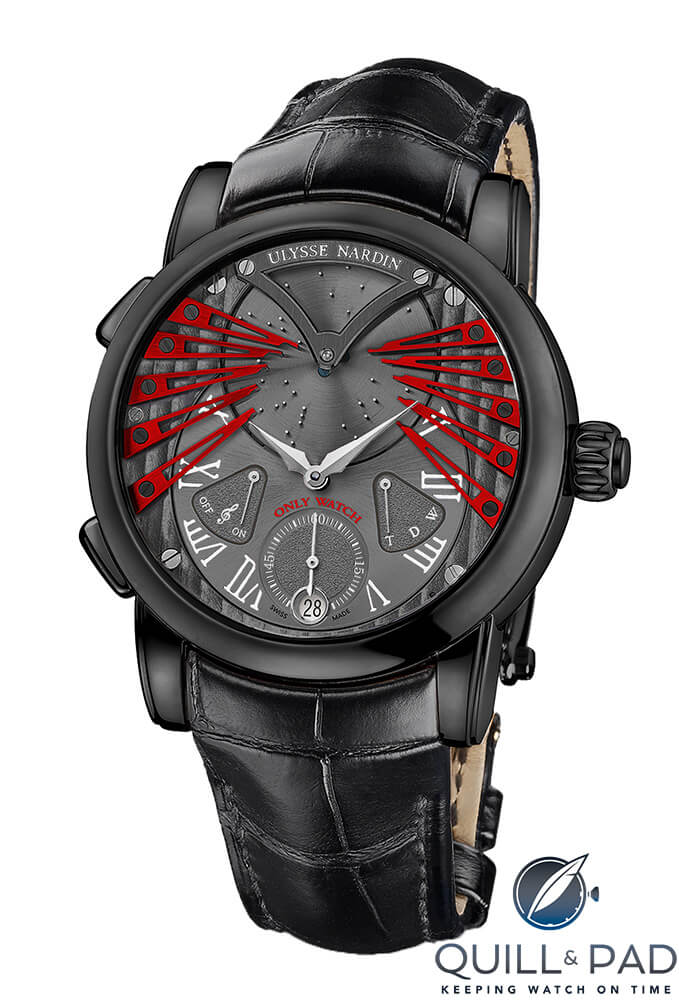
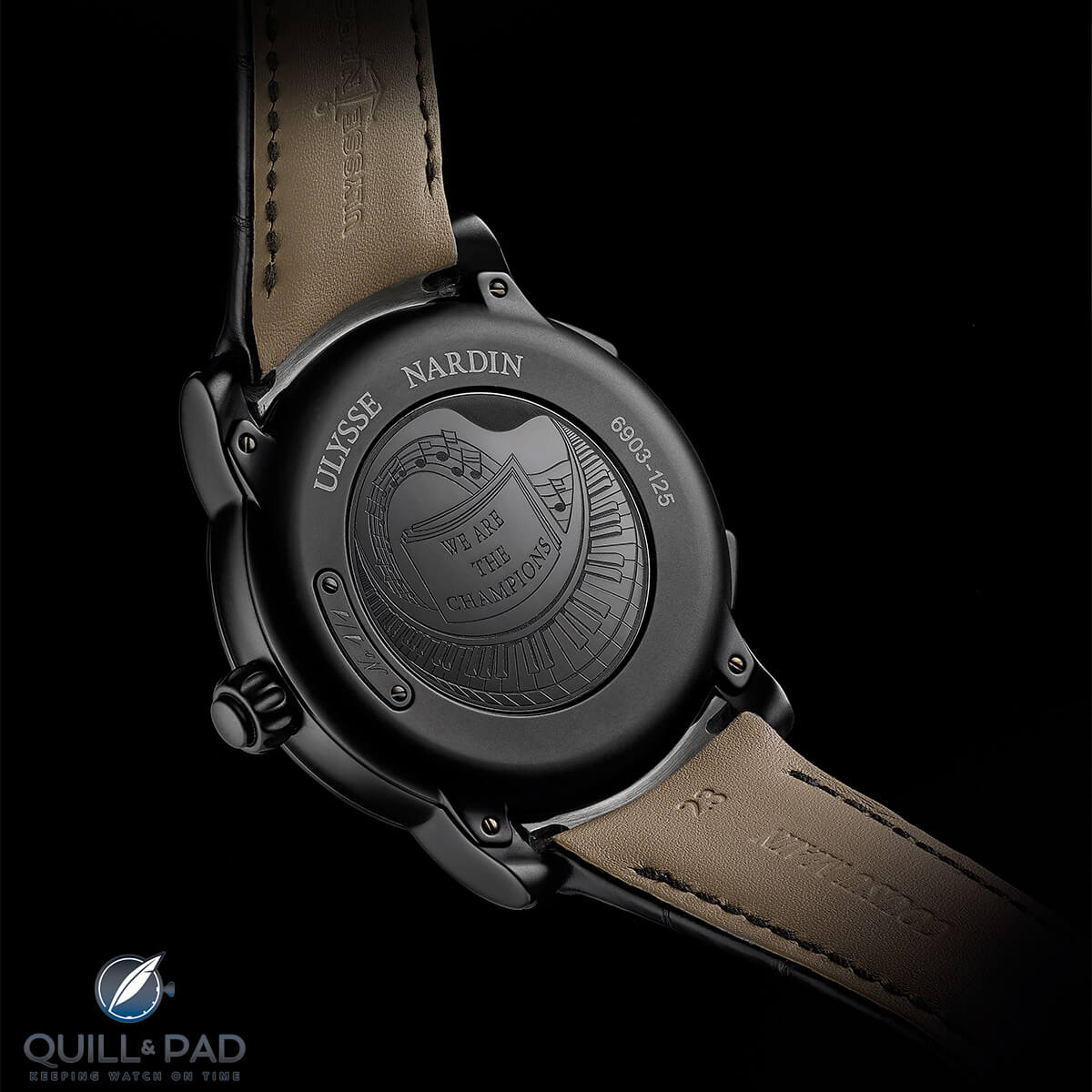

Trackbacks & Pingbacks
[…] of the Stranger musical watch (first introduced in 2013, followed by a Vivaldi version and an Only Watch unique piece in 2015) plays Qaumi Tarana, Pakistan’s national […]
[…] For more in-depth information on The Stranger, see Music Boxes And Heartfelt Causes: Ulysse Nardin Stranger. […]
Leave a Reply
Want to join the discussion?Feel free to contribute!